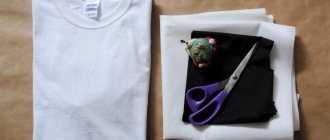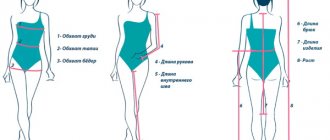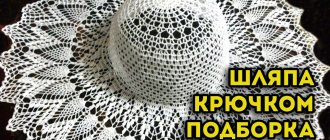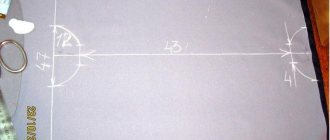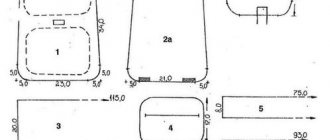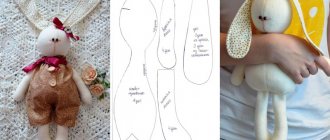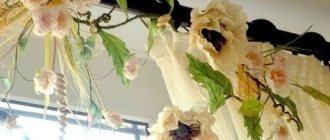A blouse is an indispensable attribute of a basic wardrobe that every self-respecting fashionista simply must have. Blouses come in different styles and colors, so everyone will find exactly what suits her taste.
There is absolutely no need to spend a fortune on an original item, because you can sew it yourself. In this article we will talk about how to make a blouse with your own hands and talk about the features of its tailoring.
Choosing knitted fabric for women's sweaters
When choosing a knitted fabric for sewing women's sweaters, take it into account:
- thickness;
- stretchability;
- density;
- compound.
In the table you can see what these indicators influence:
| Compound | Density | Stretchability | Thickness |
| For tailoring; cut; care; shrinkage; ability to absorb moisture. | For assortment; shrinkage; combination; selection of sewing needles. | For tailoring; cut; construction of patterns; choice of style. | Choice of threads and needles; cut; determination of seasonality. |
When choosing knitted material:
- Pay attention to the composition: a good fabric should contain 70-80% natural fibers, but sometimes you can prefer one that has a 50 to 50 ratio with synthetics.
- Check the canvas for electrification and clinging to the fingers. High-quality knitwear does not have a synthetic shine and is pleasant to the touch.
- Observe whether the material returns to its original shape after stretching.
- Hold the fabric up to the light for uneven weaves. If there are any, then the knitwear is of poor quality.
- They look at the cost. Cheap fabric, as a rule, turns out to be completely unsuitable.
High-quality knitwear will:
- pleasantly heavy;
- dense;
- drapes well;
- moderately stretchy;
- expensive.
Fabric calculation
Knitted sweaters for women are often combined or decorated with other materials. Blouses made of stretch fabric often have satin or guipure inserts. Sometimes knitwear is even combined with polyester.
With a fabric width of up to 100 cm, it is calculated for a sweater of size 48 inclusive: folded together with hem allowances for the bottom of the length of the product (2 pieces) and sleeves. If the canvas has a width of 140-150 cm, then all calculations are the same as in the first case, only the length of the product is added by one.
The length of the fabric is increased if the model has:
- larger than 48;
- complex style;
- pattern that needs to be combined;
- pockets and collar.
Skirt for a girl
We sew children (for girls, patterns suitable for any age) a circle skirt. The advantage of such a skirt is that depending on the fabric chosen, it will look different every time. For a light summer skirt, the following are suitable: cotton, linen, chintz, light denim. For a festive option, you can choose satin, brocade or organza.
To add pomp, you need to use the same patterns to make an underskirt from organza, lace or mesh. For a skirt, you need to take 2 measurements: waist circumference (F) and count the desired length (L). In order for the skirt to have beautiful ruffles, it is recommended to double the waist circumference.
Next you need to calculate 2 radii:
- r – for the waist. Calculation: r = (From*2)/6.28. The resulting value should be rounded up to the nearest whole number.
- R is for bottom. R = r + D.
Taking into account the data obtained, you need to make a pattern on paper. To cut a skirt on fabric, you need to fold the paper pattern into 4 times. Then also fold a piece of fabric and transfer circles onto it. If you plan to make a hem at the bottom of the model, then when cutting it is necessary to leave allowances of 1 to 2 cm.
In addition, the edge can be trimmed with braid or sewn on with lace, then allowances are not needed or are kept minimal. The circle skirt is sewn without seams. Therefore, when choosing fabric, you need to take into account that the diameter of the skirt cannot exceed the width of the fabric.
The width of the belt depends on preference. The main thing is not to forget to allow 2 cm allowance. For beginners, it is better if the length of the belt corresponds to the diameter of the circle on the belt.
Stages of work:
- The belt needs to be stitched to form a ring. In this case, it is necessary to leave a slot where the elastic band will subsequently be inserted.
- Next, this part should be folded in half and stitched to the skirt.
- The bottom of the product must be hemmed or decorated in any desired way - ribbon, braid, lace.
- At the end of the work you need to insert an elastic band. It is recommended to take the length of the elastic 10% shorter than Ot.
What do you need to sew a knitted blouse?
To work with any style of knitted sweaters, pre-prepare:
- sewing machine;
- overlock;
- pins and needles;
- soap or chalk;
- square;
- extended ruler;
- well-sharpened scissors for cutting;
- ready-made patterns.
How to cut knitwear?
Women can successfully create unique and original images by sewing their own clothes. For a beginning seamstress, if you have clear instructions and all the necessary tools, it will not be difficult at all to create a special item, for example, a jacket. Knitted products of simple and complex styles come out equally decent both with and without patterns.
When cutting blouses made of non-woven material, several nuances should be taken into account:
- the canvas must be cut exclusively with sharp scissors;
- patterns are taken with allowances marked on them;
- finished patterns are secured either with pins or something heavy;
- if it is necessary to fold the material in half, it is swept away not only around the perimeter, but also in other places;
- knitwear is cut lengthwise, except for the places marking the armholes and neckline.
Preparation of tools and materials
For independent work you will need a minimum set of tools and materials:
- Tape measure.
- Scissors with a sharp cutting edge.
- Needle, thread.
- Pencil and paper for preparing patterns (if sewing will be carried out according to patterns).
- For stylish blouses, you can prepare various decorative elements: laces, hooks, buttons, beautiful cuffs, lace on the collar.
It is better to use light material for sewing, porous enough so that the textile allows the skin to breathe properly. At the same time, one should take into account the features of practical care of the product, its resistance to shrinkage and frequent washing. Combined types of materials with the addition of acrylic meet all the requirements.
Building a basic pattern
To create a basic pattern for a knitted sweater, take the following measurements:
- chest semicircumference (SBC);
- product length (DI);
- shoulder length (HL);
- sleeve length (SL).
Before sewing knitted sweaters for women, it is important to take measurements and make a cut.
Algorithm for creating a pattern:
- The drawing begins with the construction of the front and back parts of the product.
- Draw a rectangle on thick cardboard, where AB is pog, AC is di.
- From A, a distance equal to r/3 is retreated downwards and G is marked.
- Horizontal lines are drawn from G and G1 is marked at the intersection with the side of the rectangle.
- AB is divided by 3 and marked A1 and B1.
- From them to GG1, vertical straight lines are drawn, obtaining G2 and G3 at the intersection.
- GG1 is divided in half and G4 is placed.
- From it they go down to the CD, drawing a vertical line. At the place of suppression they receive C1.
- For the armhole, bisectors with lengths of 2 and 1.5 cm are drawn from the corners G2 and G3, thereby obtaining G5 and G6.
- A1, G5, G4, G6 and B1 are connected using a smooth line.
- For the neck, a distance equal to dp is retreated from A1 to the left, A2 is marked.
- From A downwards put 2 cm and get A3.
- A2 and A3 are connected by a sliding line.
- On the front part, step back from B1 to the right, marking B2, and from B - 5-6 cm down, getting B3. The resulting points are smoothly connected.
- Everything unnecessary is erased.
Construction of a drawing for a set-in sleeve of a sweater:
- Build a rectangle with sides AB = linear/3 t AC = other.
- To obtain point O, descend from A to a distance equal to half a linear distance.
- A parallel AB is drawn from it. The intersection with BD is marked as O2.
- The resulting rectangle is divided by lines into 4 equal parts.
- The top and bottom vertices of half the rectangle are marked as B1 and B2.
- Points O2, B1 and B1, O are connected.
- A straight line is drawn from B1 downwards and the intersection with CD is marked as B3.
- To obtain B4 and B5, a distance equal to half the semicircle of the hand is retreated in 2 directions from B3.
- Next, according to the drawing, the details are shaped, after which the extra lines are erased.
- If the hips and chest are very different in size, then the bottom of the product is widened by the difference between them.
Taking measurements from a girl
In order for the clothing pattern to be accurate, you need to learn how to correctly take measurements from a child. There are no special measurement rules for babies under 3 years old. In some cases, it’s even easier to take clothes that fit a girl and take measurements based on them.
For older children, during measurements, you need to ensure that the child stands straight, with a straight back and arms down, while the body should be relaxed. Regardless of the girl’s age, before taking measurements she needs to wear underwear that fits well to her body.
| Measurement type | Symbol | Measurement Rules |
| Neck circumference | Osh | The measuring tape should be placed at the base of the neck and measure its circumference. |
| Bust | Og | The tape should pass across the widest part of the chest and the protruding points of the shoulder blades. |
| Waist circumference | From | Babies do not have a clearly defined waist, so to understand its size, you need to tie a ribbon in the abdomen and let the child move. As it moves, the tape itself will “fall” into the right place. If the child is fat with a pronounced belly, then the measurement should be taken at the most protruding place of the abdomen. |
| Hip girth | About | You need to measure along the protruding points of the buttocks and hips. |
| Chest Width | Shg | Using a measuring tape, measure the distance from the beginning of one armpit to the other. |
| Back width | Shs | From the side of the back, using a measuring tape, you need to measure the distance from one armpit to the other, and the centimeter should pass along the protruding points of the shoulder blades. |
| Head circumference | Og | Using a measuring tape, measure the circumference at its widest point. |
| Knee circumference | OK | The circumference should be measured through the middle of the knee. |
| Hip circumference | About | The measurement is taken at the widest point of the thigh. |
| Wrist circumference | Oz | You need to measure the circumference at the junction of the hand and arm. |
| Armhole length | DPR | To take a measurement, you need to tie a braid or ribbon in the same place where the Og measurement was taken. After this, you need to use a tape to measure the distance from the point of the base of the neck vertically down to the braid pointing to Og. |
Using ready-made patterns
The finished patterns are laid on the fabric and secured until immobile.
The image is outlined with tailor's chalk or a bar of soap, taking into account allowances for hems and seams. Next, all parts are cut out and basted. After fitting, the parts are machine stitched. If there is a collar, then 2 additional fabric strips with a width of 2.5 cm are prepared for it. They must be cut on the bias. At the very end, sleeves are sewn in, complemented by cuffs.
Off Shoulder Sweatshirt
For sewing you will need:
- fleece footer in two colors: floral print and plain;
- cashcorse or ribana for cuffs;
- threads, sewing tools.
Description
You can create patterns for such a model with your own hands, using our recommendations above. For beginning cutters, there are many sources on the Internet, for example, the Ottobre pattern magazine.
We prepare patterns, mark and cut out parts.
The most convenient way to sew footer parts is to use an overlocker. If it is not there, then we sew the parts together with a regular stitch using needles for knitwear. All seams are ironed after completion.
Next, we carry out sewing based on the photographs of the master class.
Old T-shirt as a pattern
Knitted sweaters for women are easy to design and sew. Having learned this, you can easily create various models for further combination with other clothes. The principles of making blouses from soft stretchable fabric are quite simple and understandable.
To sew a knitted sweater, a used T-shirt can serve as a base.
It is ripped open or circled whole. A T-shirt disassembled into parts will suit complex styles, and an ordinary one will suit simple ones. But with such an alternative pattern, the neckline of the future sweater is increased on the chest.
Fashionable blouse for all ages
The wrap blouse has won the love of many women. Comfortable and beautiful, it is easy to sew and looks beautiful. The wraparound model has a front section consisting of two halves. One half overlaps the other. The scent pleasantly narrows the waist, giving the silhouette an hourglass look. To a simple pattern at the waist line, you can sew two belts, 5 cm wide, then tie them, as shown in the picture.
A beautiful, light model will be made from a circle.
It's easy to sew without a pattern with Olga Nikishicheva.
You can get a free version from the circle. The edges of the product can be finished with contrasting piping or lace.
A flyaway from a square.
Setting up a sewing machine, installing a needle for knitwear
Before sewing a knitted product, set a stitch with a length of 2 mm on the machine and check the stitching on the flaps. In this case, you should also choose a needle with a rounded end.
Such a device will pass between the knitted fibers, correctly forming loops.
Features of working with knitwear. Useful sewing tips
Beginner seamstresses are recommended to begin their sewing work with basting. Machine processing of parts begins only after careful fitting of the temporarily hand-sewn product. With this approach, the risk of size errors is significantly reduced.
When processing the edges and neckline, the use of bias tape is allowed. For sweaters with an ethnic flavor, choose satin ribbons in rich colors or with ornaments. A product with a similar design acquires freshness and originality.
To prevent a knitted sweater from becoming too tight, the stitches are made with a margin. Be sure to try to make sure that the machine stitch matches the basted seam. The thread tension when sewing should be moderate (about 5). Suitable seam variations are selected by testing on scraps or scraps of fabric.
To maintain the elasticity of the knitwear, the cut parts of the future product are stitched with a narrow zigzag stitch with a width of up to 1 mm and a length of 3 mm. It is advisable to sweep away the details using thin threads. To finish the shoulder seams from the inside of the product, use bias tape or tape - this way they will not stretch. Seam allowances are sewn with an overlocker or a large zigzag stitch. For the same purpose, the lower hems are not done too tightly by hand.
To sew your first items yourself, choose light styles without:
- a large number of parts;
- unnecessary layers;
- folds
When the machine skips stitches under the knitted fabric when sewing, place thin paper, such as newspaper or wrapping paper. Fabrics with weak elasticity are slightly stretched when stitching. For crooked or gathered machine stitches, loosen the presser foot so that it puts less pressure on the fabric. To avoid pulled seams, the threads on the bobbin are wound slowly. Very thin knitwear is laid underneath with newspaper layers to give it the missing thickness.
Knitted sweaters for women have many styles and creation methods. Clothing made from tight-fitting fabric does not require ironing and fits even the fat ones. Blouses with excellent thermoregulation are worn in any season.
The details of the sliding knitwear, before placing them under the machine, are first sewn to each other by hand. It is very important to remember when working with knitwear that basting always goes in one direction, and subsequent sewing - in the opposite direction. With this technique, the displacement of parts is completely blocked.
An adhesive pad that saves knitwear from stretching when sewing is used for:
- neck;
- pockets;
- cuffs;
- below.
Starch or flour paste can also save the canvas from stretching. This sticky solution is used to treat the edges of the product before sewing. The finished item is subsequently washed to remove it from the fabric.
Instead of using paste under the knitwear, you can put:
- toilet or wrapping paper;
- paper towel;
- napkins.
The hems are sewn together with an overcast stitch.
The following machine stitches are suitable for working with knitwear:
- knitted;
- double;
- flat;
- zigzag;
- overcast;
- stretch;
- straight;
- universal.
Special Jersey needles are used for natural and dense fabric, and Stretch for thin fabric mixed with viscose.
Superstretch needles are suitable for working with:
- micro oil;
- lycra;
- biflex.
It is convenient to stitch and hem with a double needle:
- bottom of the product;
- armholes and sleeves;
- neck;
- collar stands;
- cuffs
Master classes on self-tailoring sweaters for women with and without patterns
Presentations teach beginners how to sew any styles of knitted sweaters.
Off the shoulder style
A dropped shoulder on the product can replace short sleeves.
It also hides the fullness of the shoulders. Sleeveless models or patterns are taken as the basis for the manufacture of such a sweater. Lines on the sides and shoulder lengthen both the front and back of the product. The pieces joined together will subsequently create a new shoulder length. After cutting, the cut out parts of the jacket are ground to 3 cm in width at the neckline and armhole.
Short sleeve style with guipure
A summer version of a blouse with short sleeves made of fine wool and with a guipure insert is made as follows:
- They take measurements.
- Drawing a pattern.
- The upper part of the base to the level of the beginning of the chest will be intended for guipure insert, and the rest of the lower part will be for knitwear.
- When transferring the pattern onto the fabric, allowances for freedom of movement (10 cm) and for seams are taken into account.
- After preliminary overcasting, the cut out parts are sewn together on a typewriter.
Long sleeve style with buttons
For a sweater with long sleeves with buttons, the pattern differs in that the front part of such a product consists of 2 shelves. Additional details also include strips of fabric allocated for fastening strips. Sleeves can be one-piece or raglan.
If there is no pattern, then knitted items can be sewn without one by following the pattern according to the measurements taken directly on the fabric. One-piece sleeves are drawn together with the front, smoothly connecting the sides of the jacket with the bottom line of the part (sleeve).
Zip style
A model of a sweater with a zipper is made similar to a product with buttons, but instead of them, a fastener is sewn into the edges of the front shelves. The zipper can be the length of the entire product or only reach half of it.
Model with lace
A ready-made knitted sweater is often combined with lace. Inserts are made from it, which are sewn overlapping onto the knitted product.
Lace appliques on sweaters are found:
- ahead;
- behind;
- On the sides.
Model with lurex
Knitwear with lurex when making blouses from it does not require too large seam allowances and free movement. This material is cut without backing, directly on the fabric. To prevent it from slipping, it is spread not on bare surfaces, but on lined sheets, for example. The edges of knitwear with lurex must be machine stitched in a zigzag pattern so that they do not fray later.
Knitted sweaters for women can be sewn even without a pattern, using, for example, an old product as a basis. This technique will be especially useful for beginners who are encountering modeling for the first time. For the same purposes, ready-made patterns are used.
Algorithm for sewing a bat-shaped sweater from knitwear with lurex:
- They take measurements.
- The fabric is folded in half so that its wrong side is on top.
- For the neckline, set aside 3 cm from the fold downwards, and 9 cm to the side.
- The shoulder and sleeve lengths are set aside from the neckline.
- The waist and hip circumferences are divided into 4 and also plotted along their lines.
- The bottom of the model and the edge of the sleeve are smoothly connected.
- All lined parts of the product are cut out and sewn.
Sweater jacket
You can easily make a new sweater out of an old sweater.
For this:
- cut off and remake the neck;
- cutouts are made on the sleeves or shortened to a length of ¾;
- sew the product on the sides to achieve a fitted silhouette;
- parts made from other materials are inserted instead of the cut parts.
How to sew a blouse for a girl with your own hands in steps
01. I cut out the details of the blouse, seam allowances are 1 cm. The front, back, and collar details are cut out on the fold of the fabric
- back - 1 piece
- front - 1 piece
- sleeve - raglan (front) - 2 parts
- sleeve - raglan (back) - 2 parts
- stand collar - 2 parts
- plank - 2 parts
02. I sew the raglan sleeves (front + back) together, overcast the edges with an overlocker; if you don’t have an overlocker, you can replace them with a zigzag stitch, which is available in any sewing machine.
I press the seams onto the ironing pad, directing the seam to the front. What does it mean? Raglan, like any sleeve, has a front and a back. There is a control point on the front of the pattern.
03. I sew the sleeves alternately, first to the back, then to the front.
How to decorate the finished product?
It is advisable to think through the decor for clothes in advance, even before the item is created.
Finished knitwear products are usually decorated with:
- crocheted flowers;
- fur or leather appliqués;
- rhinestones;
- sequins;
- beads;
- hand embroidery from floss.
Making knitwear yourself is not a difficult task. With the help of a sewing machine and tailoring skills, it will not be difficult for a woman to replenish her wardrobe with original and stylish sweaters.


